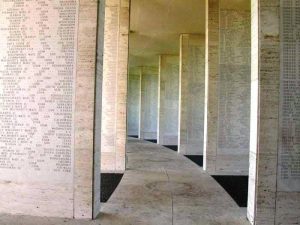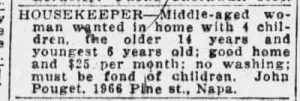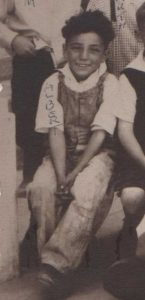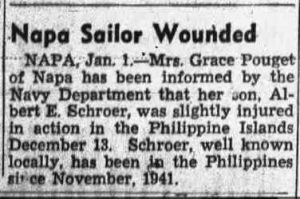“We’re so sorry Uncle Albert ….” – Paul and Linda McCartney

In the fall of 1978, shortly after our marriage, I was introduced to various members of my bride’s family. While our families were different in many ways, they were inherently the same, causing the young family historian in me to take note about who was who with regard to my wife’s relatives. One of the relatives to whom I was introduced was “Uncle Albert.”
I should mention that have I never actually met Uncle Albert. I never shook his hand or spoke with him. However, Uncle Albert was to become one of my most poignant and memorable “brick walls.”

We just learned that Albert was born in November of 1915. He looks to have spent some of his early life in an orphanage with his mother’s circumstances remaining unknown.[i] By 1924 his mother “Grace Dahl” had answered an ad in the Oakland Tribune to work in the household of my wife’s grandfather, John B. Pouget, of Napa, California.[ii]
My mother-in-law Pearl Pouget recalled that she and the other children had already chased off some perfectly good housekeepers, and that she and the other children were not especially kind to this newest one. This latest housekeeper happened to bring with her a young son by the name of Albert – she would become the new Mrs. John B. Pouget, making Albert a part of the family.

Suffice it to say that Albert had some trouble fitting in. I am sure everyone tried, and before long Albert and Pearl even had a new baby sister Lois to share between them. About 1940 things still weren’t going too well for Uncle Albert, so he joined the Navy. Albert didn’t know it then of course, but he wouldn’t be coming home. Albert would be at first designated as MIA, and then presumed deceased when his body was never recovered from the war in the Pacific.
My wife Nancy was a little girl in the 1950s and 1960s. She grew up listening to Albert’s mother, now her grandmother, and watched Mrs. Pouget dust the picture of Albert in his military uniform. Nancy watched her grandmother as she reflected on the Purple Heart medal given to her son. Nancy’s grandmother passed away in the late 1960s leaving my wife to wonder, just who was Uncle Albert? With the whereabouts of Albert’s picture and his Purple Heart (still) unknown, had she just imagined all of these things?
By the 1990s my mother-in-law had few recollections of her step-brother “Albert Dahl.” Pearl was just rueful that she had not been more kind to the young man who had never come home from the war.[iii] And for the past 40 years, my wife Nancy has asked her family historian husband to “Please find Uncle Albert…..”
Now, I know I’m not going to find Uncle Albert. Albert died in the Pacific. But like my wife, I have wanted to know just who was he?
Yet I had nothing to go on. I combed through census records. I looked at them repeatedly to find any mention of an “Albert Dahl” in Napa, California – heck, for that matter anywhere in California. I simply had no luck. The same was true for military files. I’d find an “Albert Dahl” or two, but they would never quite fit. I back tracked through pension record payments, but the fire of 1973 had destroyed so many of these that this was also another brick in the wall.[iv] I kept thinking maybe Albert’s name wasn’t “Albert” after all – that perhaps he used his middle name – and wherever I looked I found 40 years worth of nothing.
Then the brick wall started to crumble. Serendipitously, it was Memorial Day weekend and I was perusing old editions of the Oakland Tribune (on an entirely unrelated matter) when I discovered the clipping at right:

Albert, of course, is still missing, but he will always be our personal hero. For Nancy and me it has always been about getting to know this young man was whose life was so brief, and who gave up so much. “Albert E. Schroer” is memorialized at the Manila American Cemetery and Memorial in the Philippines along with 36,286 others, missing in action.[vi] [vii]
You are not forgotten Uncle Albert, rest in peace.
Notes
[i] The Oakland Tribune, 30 July 1921, 19, refers to “Albert Dahl,” age 5, at the Fred Finch Orphanage in Oakland, California.
[ii] The Oakland Tribune, 10 December 1923, 24.
[iii] Family recollections of Pearl Pouget Bloodgood (1918–2008), step-sister to Albert Schroer.
[iv] “The National Personnel Records Center Fire (12 July 1973),” The American Archivist, 37: 4, October 1974.
[v] The Oakland Tribune, 1 January 1942, 6.
[vi] American Battle Monuments Commission, www.abmc.gov/sites/default/files/publications/Manila_Booklet.pdf.
[vii] Findagrave.com memorial no. 56757651.
Did you ever figure out the story behind the surname difference?
Linda, thank-you for asking. – No, the difference in surnames was very much a surprise to us as well. He was only ever referred to as “Albert Dahl.” We think he may have taken his father’s surname of “Schroer” (possibly) upon entering the service.
An amazing story. The Find-A-Grave listing adds a bit more, but this is a story that is crying to be explored and reported in more detail.
Thank-you Bruce – so many, many lost! We have started the process by ordering Albert’s military files. Hopefully through these we can learn something more about just who “Uncle Albert” was. I appreciate your kind words.
What a wonderful story. I have a feeling that you WILL find him one of these days. Until then Rest in Peace Uncle Albert.
The Japanese overtook the Philippines a few days after the Pearl Harbor attack. American citizens there were taken to dreadful prison camps for the duration of the war. Since Albert was in the military, he probably was not in one of these camps, I assume military personnel were placed in other camps; but the timing mentioned in the clipping brings to mind that you might check prisoner of war records.
Story beautifully and thoughtfully told, Jeff. I agree with Bruce. This is a story begging to be told, and possibly needing to be heard. I know these kinds of stories often turn into rabbit holes, but I hope you decide to take it on.
It’s the MIAs that are the most troubling to survivors. The never knowing exactly where or what happened to a loved one. In an in-law’s case, he and his family already knew where his USAAF pilot uncle died (Jaluit, Marshall islands), but not the how, so I was asked to look into it. My WWII research experience has always been Britain and the Allies in the European Theatre, with regimental histories of U,S, air branches takes a bit of searching but when found are quite detailed. Not so, I learned, for the Pacific Theater. But I *did* learn more than I ever wanted to know about geography in that ocean! Jaluit, it turned out, wasn’t big enough to be called an “island” and therefore isn’t labeled on most maps. It’s a horseshoe-shaped atoll comprised of 90-some big rocks poking above the water, the entire acreage of which barely adds up to 9 sqare miles. Trying to identify just which rock Uncle Lloyd’s plane crashed on would be nigh on impossible. That is IF it crashed on a solid mass, and if it did, the size of the atoll’s masses being so tiny, most likely it immediately slid into the water, making it forever hidden forever from search aircraft. Or he might not have gone down “on” or near Jaluit at all, it was only his last reported location. So this is what I regretfully and sadly reported to the in-law.
If a loved one died fighting in France, Belgium, Italy or Germany, there’s a village or battle co-ordinates to visit. Rarely so in the Pacific. At least there’s a memorial stone for “Uncle Albert” in the Philippines, as there is for Uncle Lloyd in the family cem near Elkhart IN. I’ve always said it’s impossible not to learn geography when exploring family history, but if anyone ever asks me to explore another WWII pilot’s death in the Pacific Theater, I’ll think I’ll point them to the National Archives!
Is my face red for the blatant typos (plural) in “Theatre, with regimental histories of U,S, air branches takes a bit of searching”! Had I bothered to read through the post before hitting “Post Comment”, it would’ve read “Theatre. [new sentence] WWII regimental histories of U.S. air units take a bit of searching”.
He might have had to file some sort of late Birth Certificate with that second surname you have found. My Dad had a Foster Unckle born to his Foster Mother before she was married to the Grandparents I remember. They had legally adopted my Dad and this Uncle became part of my Genealogical research. He had to file a late Birth Certificate to prove his connection and I happened onto it like you said “when looking for something else”. He had filed it himself in order to apply for Social Security at the time.
Thanks for this moving story. And thanks for helping me to learn a bit more about my dad’s uncle who died in the Philippines Dec 8, 1941. I knew he died in WWII, but after reading your article I searched for him in the Manila American Cemetery and found a Find A Grave record for him. Now I know what group he was with, and have a picture of his grave. So many graves, and each one has a story.
That is a moving story. We may never know too much about this man, but let us remember that we are here, and we are free, because of so many like him.